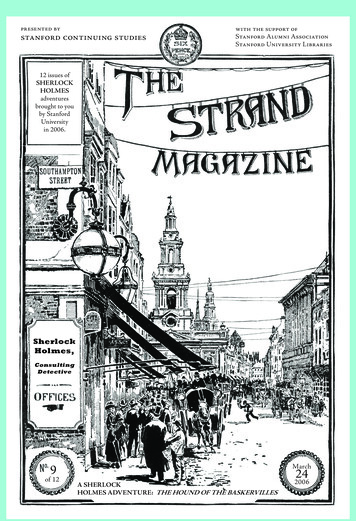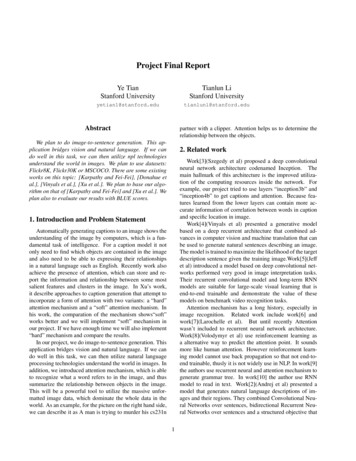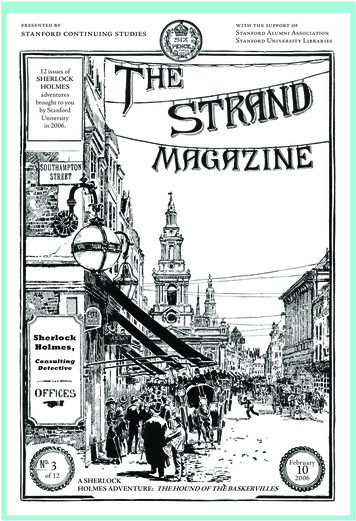
Transcription
presented bystanford continuing studieswith the support ofStanford Alumni AssociationStanford University Libraries12 issues ofSHERLOCKHOLMESadventuresbrought to youby StanfordUniversityin 2006.SherlockHolmes,ConsultingDetectiveMarch9of 1224A SHERLOCKHOLMES ADVENTURE: THE HOUND OF THE BASKERVILLES2006
Thank You!mDiscovering Sherlock Holmes was conceived byStanford Continuing Studies; from its beginning, ithas enjoyed the generous support of many at Stanfordand in Palo Alto. Those who gathered around thisidea have given cheerfully of their enthusiasm, theircreativity, their time, and their financial support.Many, many thanks to all of them.For more notes, illustrations,and background information,please visit our website athttp://sherlockholmes.stanford.eduIf your copy has not arrived by the end of the following week,please contact us at sherlockholmes@stanford.edu or at 650-724-9588,and we will mail you another copy immediately.PREVIOUSLY INTHE HOUND OF THE BASKERVILLESCHAPTER 10The day after their adventure on the moor,Watson and Sir Henry are both low-spirited, andthe dismal weather reflects their mood. Watsonrecords in his diary all the evidence that a supernatural agency might be at work, but he refuses tobelieve in such a thing.Barrymore is angry about Sir Henry andWatson’s attempt to apprehend Selden. Sir Henryinsists that they had a right to try to catch such adangerous criminal before he hurt someone else.When Barrymore reveals that plans are afoot tohelp Selden leave the country, Sir Henry agrees notto pursue him further.In return, Barrymore reveals a bit of informationabout Sir Charles’s death that he stumbled across after the inquest. Mrs. Barrymore found a fragment ofa burnt letter at the back of the hearth. It had arrivedthe morning of Sir Charles’s death, and contained aplea by a woman who wished him to meet her at thegarden gate in the yew alley, the place where he methis death. Her initials were “L. L.”Watson meets Mortimer, who has lost hisspaniel on the moor. Mortimer says that the onlywoman with the initials “L. L.” in the area is LauraLyons, daughter of Old Frankland, the man who isknown as a crank for his continual litigation. Shehad fallen on hard times when her ne’er-do-wellhusband deserted her. The local gentry, includingSir Charles, took up a collection to establish her ina typewriting business. Watson decides to find herand ask about the letter.Barrymore reveals to Watson the disturbingnews that Selden has not been heard from for threenights. Moreover, Selden had told Barrymore thathe saw a stranger out on the moor, but, apart fromthe man being a gentleman, he knows nothing elseabout him. Watson resolves to find the mysteriousman and get to the bottom of the matter.CHAPTER 11Watson sets off for the village of Coombe Traceyto interview Laura Lyons about her letter to SirCharles. Suspicious and defensive, she at first denieshaving written to Sir Charles. When Watson quotesthe bit of the letter that remained unburned, she admits that she had asked to see Sir Charles on a privatematter. After persistent questioning, Watson learnsthat Mrs. Lyons needed money in order to divorce herhusband, who was trying to force her to live with him.She claims that help came from another source, so shedid not keep the appointment, but refuses to tell Watson the details. Finding that he has reached a deadend, Watson decides to begin his search for the otherman on the moor, wondering if he was the beardedman who had shadowed Sir Henry in London.On the way home, he passes the home of Frankland, Mrs. Lyon’s estranged father, who invites him inside for a celebratory glass of wine. Frankland has wontwo lawsuits on matters that seem designed to annoyhis neighbors. He complains to Watson that the local constabulary provides inadequate protection whenthe local people burn him in effigy or take other sortsof revenge, but that, in return, he is withholding someinformation that the constabulary would love to have.He has seen a child crossing the moor with food, andimagines that it is intended for the convict. Knowingthat Barrymore takes Selden his food, Watson concludes that the child must be bringing food to the mysterious stranger. At that moment, Frankland spots thechild on the hillside and shows him to Watson throughthe telescope that he uses to spy on his neighbors.Quickly taking his leave, Watson follows the boy’strail and discovers a stone hut that has retained partof its roof. Inside, he finds evidence that someone isliving there, as well as a paper that says, “Dr. Watsonhas gone to Coombe Tracey.” He resolves to waituntil the man returns to find out whether he intendsgood or evil.With apprehension, he hears the stranger returning. A shadow falls across the doorway, and a familiar, friendly voice invites him to come outside.
2
3
4
5
6
7
8
9
NOTES AND ILLUSTRATIONSI stooped under the rude lintel, and there he sat upona stone outside, his grey eyes dancing with amusementas they fell upon my astonished features. (1)Just as Holmes enjoyedtrumping Watson’s deductions about the walking stick at the beginningof the story, now he revelsin his friend’s astonishment.“.for when I see the stubof a cigarette markedBradley, Oxford Street,I know that my friendWatson is in the neighbourhood.” (1)This imaginary tobacconist’s shop wouldhave been located just afew blocks from BakerStreet.I was still rather rawover the deception whichhad been practised uponme, but the warmth ofHolmes’s praise drovemy anger from my mind.(3-4)Holmes and Watson hear the hound before they seeit. The hound is an elusive presence in the story — anauthorial choice thatmakes the beast morefrightening and formidable when it finallydoes appear. Illustratorsof Hound must decidewhat conception of thehound will have maximum impact. Is it betterto represent the beastas a monster, or to leavehim a shadowy presence?Filmmakers face thesame dilemma.At left, the cover illustration for the firstcomplete edition ofHound shows the animalin silhouette againstthe moon. The stylish,art-deco cover sports ared background withgold tracery and question marks. The interiorillustrations by SidneyPaget had appearedin the original StrandMagazine series. Thisedition was publishedin England by GeorgesThis cover illustration is signed “A.G.J.,”Newnes, owner of Thethe (unknown) artist’s initials.Strand Magazine, in1902.Holmes often hurtsWatson’s feelings bywithholding information from him. Later,Holmes has a logicalexplanation for his deception, and Watson alwaysforgives him. For information about an interesting made-for-TV version of Hound that exploresthis dynamic in depth, see the Masterpiece Theatrewebsite: www.pbs.org/wgbh/masterpiece/hound/.Richard Roxburgh and Ian Hart give studied andemotional performances as Holmes and Watson,while the hound itself, a computer-generated nightmare, is perhaps less successful than the humanelement. The story is somewhat altered from theoriginal in order to focus on Holmes and Watson’sdifficult friendship.When I learned that the missing man was devoted toentomology the identification was complete. (4)It is ironic that Stapleton’s one harmless passion, thestudy of insects, leads to his downfall.And a new sound mingled with it, a deep, mutteredrumble, musical and yet menacing, rising and fallinglike the low, constant murmur of the sea. (5)There could be no doubtabout the beetling forehead, the sunken animal eyes. (7)Again, Watson emphasizes Selden’s “beetling”—orNeanderthal—brow and his “animal” eyes to showthat he is a “born” criminal. Perhaps this is one reasonthat Holmes and Watson neglect to take much troubleover Selden’s corpse, while, if it had been Sir Henry’sbody, they might have considered carrying it to thehall.“My difficulty is the more formidable of the two, for Ithink that we shall very shortly get an explanation ofyours, while mine may remain for ever a mystery.” (7)Holmes is right: Watson’s question is answered a fewparagraphs later, while Holmes’s own “difficulty” mustwait until the end of the story for its explanation.“Sufficient for tomorrow is the evil thereof.” (9)Holmes paraphrases the King James New Testament:“Sufficient unto the day is the evil thereof ” (Matthew6:34).
NOTES AND ILLUSTRATIONSHOUND ON FILMNorwood’s performances, and once gave him a HolOut of perhaps 250 films involving Holmes inmesian dressing gown as a gift, which Norwood woresome capacity or other, The Hound of the Baskervillesin the films. Filmed on location in Dartmoor, thehas been made into feature films at least 20 timesNorwood Hound featured over-the-top acting, typicalsince 1914, not counting the many television versions.of the silent film era, plus a hound whose jowls wereEach version has its own quirks; a few havemade to look fiery – none too successlittle or no relationship to the book. Mulfully – with scratches on the film.tiple versions exist in English, German,Basil Rathbone is considered byFrench, Italian, and Russian.many to be the foremost interpreter ofBritish silent film actor Eille NorHolmes. Visually, Nigel Bruce as Watwood, who has the distinction of havingson appears slightly too elderly, but itmade more Holmes films than anyoneis the buffoonish behavior written into(47 in all), starred in a 1921 silent versionthe scripts that viewers have criticizedof Hound. His Holmes, forced to speakmost. Fortunately, the rapport betweenonly through caption cards, was also slowRathbone and Bruce does not disapmoving and deliberate, because Norwoodpoint. Their first outing together assaw Holmes as a man who could not beHolmes and Watson was a 1939 versionThe Rathbone-Bruce of Hound, and its success inspired 13rattled. (Our modern Holmeses, such asHound is availableBasil Rathbone and Jeremy Brett, tend tomore films, several only loosely basedon DVD.be more highly strung.) Norwood’s filmson the Conan Doyle canon.were set in post-World-War-I England,The Rathbone-Bruce version ofnot in Victorian times, as Conan Doyle would haveHound captures the original’s feeling of the moor’spreferred. Aside from that small quibble, he enjoyedspooky landscape, even with studio sets. By necessity,the film plays fast and loose with the plot, in order tosqueeze a 15-chapter novel into a film that is less than90 minutes long. Its memorable last line of dialoguerefers rather strangely to Holmes’s drug habit. AsHolmes says a hasty good-night and rushes from theroom, he shouts, “Quick, Watson, the needle!”Jeremy Brett and Edward Hardwicke’s portrayalsof Holmes and Watson in Granada’s 1988 productionof Hound for British television remains the favoriteversion of many viewers. The plot remains largelyintact, although the pacing of events is, of necessity,somewhat condensed. Brett’s eccentric and neurotic,but appealing, portrayal of Holmes is unique.In a 2003 Masterpiece Theatre version shown onPBS, Richard Roxburgh and Ian Hart give studiedand emotional performances as Holmes and Watson,while the hound itself, a computer-generated nightmare, is perhaps less successful than the human element. This version is distinguished by its emphasison Holmes and Watson’s friendship in the contextof the story. The PBS Masterpiece Theatre web sitecontains extensive material on both versions: http://www.pbs.org/wgbh/masterpiece/hound/. The storyis somewhat altered from the original in order to focus on Holmes and Watson’s difficult friendship.Basil Rathbone did not get top billing in this versionof Hound, but was upstaged by a matinee idol namedRichard Greene, little remembered today.OTHER MEMORABLE HOUNDSDer Hund von Baskerville. Dir. Carl Lamac.Perf. Bruno Güttner and Fritz Odemar. OndraLamac, 1937. A series of silent films loosely based onThe Hound of the Baskervilles was made in Germanyfrom 1914-1921, and another in 1929. This 1937“talking” film was one of two movies found in Hitler’sbunker at his death. The other was Der Mann, werSherlock Holmes war (The Man who was Sherlock
NOTES AND ILLUSTRATIONSHolmes; 1937), about two con men who impersonateHolmes and Watson. It is known that Hitler lovedmovies, but we have no indication what he thought ofSherlock Holmes.The Hound of the Baskervilles. Peter Cushing andAndré Morell. Hammer Films, 1959. First colorversion of Hound.The Hound of the Baskervilles. Stewart Grangerand Bernard Fox, Universal 1972. A made-for-TVmovie, with William Shatner as Stapleton, that received less than glowing reviews.The Hound of the Baskervilles. Peter Cook andDudley Moore, Michael White, 1978. “A GrimpenMire of comic enervation”—Financial Times. “Trulyone of the crummiest movies evermade”—Time Out.Priklyucheniya Sherloka Kholmsai doktora Vatsona: Sobaka Baskerviley, (The Hound of the Baskervilles).Dir. Igor Maslennikov. Perf. VasiliLivanov and Yuri Veksler. Gostelradio/Lenfilm, 1981. One of a series ofSherlock Holmes mysteries filmed forRussian television from 1979 to 1986.For more information about movieand TV versions of Sherlock Holmesstories, see: Alan Barnes. Sherlock Holmes on Screen: AComplete Film and TV History. Reynolds & Hearn:London, 2002. Internet Movie Database. www.imdb.com. Scott Allen Nollen. Sir Arthur Conan Doyle atAbove, Rathbone andBruce as Holmes andWatson.Left, in this poster for the1939 Hound, the houndis represented only by itsbloodstained footprints.the Cinema. McFarland: London, 1996. PBS Masterpiece Theatre—The Hound of theBaskervilles. http://www.pbs.org/wgbh/masterpiece/hound/.A DOUBLE BARRELED DETECTIVE STORY 1902 — by Mark TwainAmerican author and satirist Mark Twain(actually Samuel Clemens, 1835-1910) wrotea parody of Sherlock Holmes stories in 1902,soon after reading The Hound of the Baskervilles.In this pastiche, a child is born with a hound’s heightened sense of smell because his mother was frightenedby dogs when she was pregnant with him. The mainattraction of the story is a pretentious and bumblingSherlock Holmes who visits a mining camp, where heis called upon to solve a mystery, only to be outdone bythe young man who can follow a scent like a hound. Inthis first passage, the miners are quite impressed withSherlock and enjoy watching him think:Meantime the road in front of the tavern wasblocked with villagers waiting and hoping for aglimpse of the great man. But he kept his room, anddid not appear. None but Ferguson, Jake Parker theblacksmith, and Ham Sandwich had any luck. Theseenthusiastic admirers of the great scientific detectivehired the tavern’s detained-baggage lockup, whichlooked into the detective’s room across a little alleyway ten or twelve feet wide, ambushed themselves init, and cut some peep-holes in the window-blind. Mr.Holmes’s blinds were down; but by and by he raisedthem. It gave the spies a hair-lifting but pleasurablethrill to find themselves face to face with the Extraordinary Man who had filled the world with the fameof his more than human ingenuities. There he sat- not a myth, not a shadow, but real, alive, compact ofsubstance, and almost within touching distance withthe hand.“Look at that head!” said Ferguson, in an awedvoice. “By gracious! that’s a head!”“You bet!” said the blacksmith, with deep reverence. “Look at his nose! look at his eyes! Intellect?Just a battery of it!”“And that paleness,” said Ham Sandwich. “Comesfrom thought–that’s what it comes from. Hell! duffers like us don’t know what real thought is.”“No more we don’t,” said Ferguson. “What we takefor thinking is just blubber-and-slush.”
NOTES AND ILLUSTRATIONS“Right you are, Wells-Fargo. And look at thatfrown–that’s deep thinking–away down, down, fortyfathom into the bowels of things. He’s on the track ofsomething.”“Well, he is, and don’t you forget it. Say—look atthat awful gravity—look at that pallid solemness—there ain’t any corpse can lay over it.”“No, sir, not for dollars! And it’s his’n by hereditary rights, too; he’s been dead four times a’ready, andthere’s history for it. Three times natural, once byaccident. I’ve heard say he smells damp and cold, likea grave. And he—”“ ‘Sh! Watch him! There - he’s got his thumb onthe bump on the near corner of his forehead, and hisforefinger on the off one. His think-works is just agrinding now, you bet your other shirt.”“That’s so. And now he’s gazing up toward heavenand stroking his mustache slow, and– ”“Now he has rose up standing, and is putting hisclues together on his left fingers with his right finger.See? he touches the forefinger—now middle finger—now ring-finger—”“Stuck!”“Look at him scowl! He can’t seem to make outthat clue. So he—”“See him smile!—like a tiger—and tally off theother fingers like nothing! He’s got it, boys; he’s gotit sure!”“Well, I should say! I’d hate to be in that man’splace that he’s after.”Later, Holmes sums up the case using his famousmethod.When quiet fell, Mr. Holmes resumed:“We perceive, then, that three facts are established, to wit: the assassin was approximately lightwitted; he was not a stranger; his motive was robbery,not revenge. Let us proceed. I hold in my hand a smallfragment of fuse, with the recent smell of fire upon it.What is its testimony? Taken with the corroborativeevidence of the quartz, it reveals to us that the assassin was a miner. What does it tell us further? This,gentlemen: that the assassination was consummatedby means of an explosive. What else does it say? This:that the explosive was located against the side of thecabin nearest the road—the front side—for withinsix feet of that spot I found it.“I hold in my fingers a burnt Swedish match—thekind one rubs on a safety-box. I found it in the road,six hundred and twenty-two feet from the abolishedcabin. What does it say? This: that the train wasfired from that point. What further does it tell us?This: that the assassin was left-handed. How do Iknow this? I should not be able to explain to you,gentlemen, how I know it, the signs being so subtlethat only long experience and deep study can enableone to detect them. But the signs are here, and theymStanford is happy to invite you,free of charge, to encounterSherlock Holmes as Victorianreaders would have done. If youwould like to see thisproject continue, considerdonating to DISCOVERINGSHERLOCK HOLMES.Donate online athttp://sherlockholmes.stanford.eduor send a check toDiscovering Sherlock HolmesStanford Continuing Studies,482 Galvez Street,Stanford, CA 94305-6079.(Make checks payable to Stanford University,but please note “Discovering SherlockHolmes” in the memo line. Thank you!”)are reinforced by a fact which you must have oftennoticed in the great detective narratives – that all assassins are left-handed.”“By Jackson, that’s so.” said Ham Sandwich,bringing his great hand down with a resounding slapupon his thigh; “blamed if I ever thought of it before.”“Nor I!” “Nor I!” cried several. “Oh, there can’tanything escape him—look at his eye!”Twain’s Holmes accuses the wrong man. Worse,the murder was committed right under Holmes’s nose,and he was set up by the murderer to serve as an alibi.After Holmes pronounces his verdict, Stillman, thehound-man, proves him wrong point by point, parodying some of Holmes’s words to Watson over Dr. Mortimer’s walking stick at the beginning of Hound.“The criminal is present, I believe. I will show himto you before long, in case I am right in my guess.Now I will tell you all about the tragedy, from startto finish. The motive wasn’t robbery; it was revenge.The murderer wasn’t light-witted. He didn’t stand sixhundred and twenty-two feet away. He didn’t get hitwith a piece of wood. He didn’t place the explosiveagainst the cabin. He didn’t bring a shot-bag withhim, and he wasn’t left-handed. With the exceptionof these errors, the distinguished guest’s statement ofthe case is substantially correct.”The full text of this story is readily available online.
STANFORD, CALIFORNIA 94305-6079STANFORD UNIVERSITY482 GALVEZ STREETSTANFORD CONTINUING STUDIESDISCOVERING SHERLOCK HOLMESPOSTMASTER! PLEASE DELIVER BY MARCH 24!PERMIT NO. 28PALO ALTO, CAPAIDU.S. POSTAGENON-PROFIT ORG
SHERLOCK HOLMES adventures brought to you by Stanford University in 2006. March 24 A SHERLOCK 2006 HOLMES ADVENTURE: THE HOUND OF THE BASKERVILLES. If your copy has not arrived by the end of the following week, please cont










